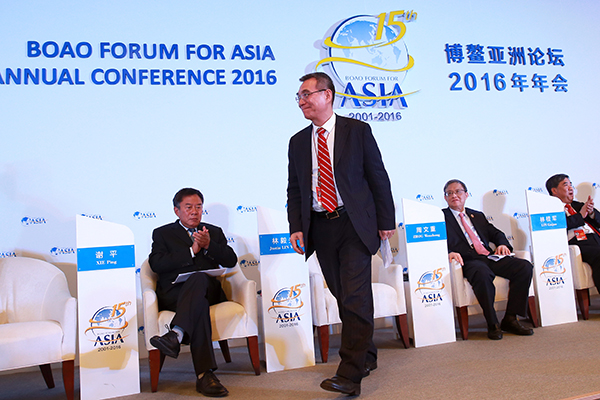Growth of emerging economies impressive in 2015
 0 Comment(s)
0 Comment(s) Print
Print E-mail China Daily, March 23, 2016
E-mail China Daily, March 23, 2016
 |
|
Justin Yifu Lin (standing), a professor of economics at Peking University and former World Bank chief economist, attends a news conference at the Boao Forum for Asia Annual Conference in Boao, Hainan province, on March 22, 2016. [Photo/China Daily] |
Major emerging economies maintained their positive growth momentum under slow global economic conditions in 2015 and there is no need to be pessimistic about their long-term ability to develop, according to a report released on Tuesday by the Chinese Academy of Social Sciences.
The Development of Emerging Economies Annual Report 2016, released at the annual Boao Forum for Asia in Hainan province, said that the economic growth of the 11 major emerging economies, or E11, slowed in 2015, but less than developed economies.
The 11 economies, which are also members of the G20, are Argentina, Brazil, China, India, Indonesia, South Korea, Mexico, Russia, Saudi Arabia, South Africa and Turkey.
Data from the International Monetary Fund said the E11's economic aggregate, based on the market conversion of market exchange rates, amounted to $22.28 trillion in 2015-30.3 percent of the global total and a 1 percentage point increase from 2014.
Even though the overall growth of the E11 slowed, growth remained impressive compared to the advanced economies in Group of Seven countries and the European Union, the report said.
In 2015, the average growth rate of both the G7 and the EU was 1.9 percent, far below the E11's 4.5 percent-though different dynamics were at play. The G7 and EU logged growth after a long period of stagnation, indicating a slow recovery, while the E11 economies slowed in the face of downside pressure.
Zhang Yuyan, director of the Institute of World Economics and Politics at the Chinese Academy of Social Sciences, said the E11's slower economic growth is closely related to its deepening of internal reforms and structural adjustments, including a slight decline in private consumption, a weaker investment-driven force and a gradual decrease of net exports.
Annual event
The theme of this year's forum is "Asia's new future: New dynamics, new vision". The forum will run through March 25, with 88 sessions, including 51 forums, 14 roundtables, six themed dinners and 12 entrepreneur dialogues.
A total of 2,100 representatives, including 1,122 heads of global and domestic companies from 62 countries and regions are participating in this year's forum.
"For Asian countries, the economy is still growing, but at a slower pace. And it is facing more challenges," said Zhou Wenzhong, secretary-general of the BFA.
Zhou said China, Asia's largest economy, will experience more positive factors in its economy, including a soft landing featuring the shift from high growth to medium-to-high growth.
"Big-ticket railway, airport and water conservation projects, easing of monetary policy, the shifting of real estate sales in certain regions in the second half of last year and the ongoing supply-side reform all helped the country put its economy on a firmer footing in 2015," said Justin Yifu Lin, a professor of economics at Peking University and former World Bank chief economist.
Supply-side reform, which represents a profound change in China's economic model, was underlined by the central government late last year. It includes a series of policies to improve public service, environmental protection, quality of production and further opening-up to the global economic system.






Go to Forum >>0 Comment(s)